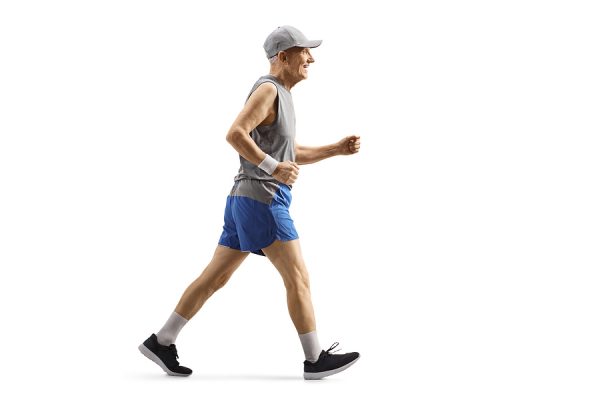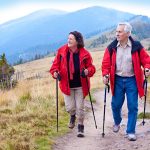Growing old gracefully is something everyone strives for. But sometimes life catches up with you faster than you realize.
The next thing you know, you’re looking older and feeling weaker than you would like. Your muscles and bones aren’t as strong as they used to be. Your gait speed drops to that of a snail and you start forgetting things.
You might think this only happens to “old” people. But a slow gait speed can begin much earlier in life.
We already know that when people are slow walkers in their 40’s, they tend to look much older than their faster-walking counterparts.
They also have accelerated aging in multiple organ systems. Their brain volumes are smaller. They show more cortical thinning and a greater number of white matter lesions. All of this is linked to mental decline and dementia.
In other words, slow paced 45-year-olds are practically geriatric!
But when it comes to seniors with a slow gait speed, the problems can become more apparent. And as a physician, I often use gait speed to get a handle on the general health, physical mobility and frailty of some of my older patients.
It can be an indication that older patients will have more unplanned hospitalizations and emergency department visits for falls and other conditions related to frailty. They are more likely to perform worse on cognitive tests and develop dementia. Even worse, men and women over the age of 65 who walk the slowest have a 10-year survival rate of just 19% to 35%.
In the meantime, those who walk the most briskly have survival rates of 87% to 91% over the course of the next 10 years.
Build Muscle to Improve Gait Speed
If you walk slowly out of habit, there is an extremely effective way to get yourself moving faster.
Just listen to music with a relatively fast beat, and time your steps to the beat. (If you prefer not to bring music, try creating your own chant to keep your feet moving faster. Think of the old military cadence: Left, left, left-right-left.)
But in many cases, a slower walking speed is due to a loss of muscle mass and bone strength in the legs and lower body. However, there are plenty of ways to incorporate some very easy strength and bone-building exercises into your daily activities.
For example, getting up and down from a chair can go to work immediately to build strength in the leg and trunk muscles that are so critical for walking. And it is so easy to do!
Just stand with your back to a sturdy chair. Place your arms straight out in front of you and your feet shoulder-width apart. Bend your knees and slowly lower your rear-end toward the seat of the chair while you count to five. Keep your knees above your ankles and your back straight as you lower yourself.
Once seated, slowly rise out of the seat to a count of three. Repeat ten times, rest for a minute or two, then perform the exercise 10 more times.
Change the Way You Walk
Another easy way to improve muscle strength, bone density and balance is by taking part in something called “odd-impact” exercises.
The concept is really quite simple: Instead of walking forward all of the time, switch things up by walking backwards, sideways and making frequent turns. Take paths that go uphill, downhill and have multiple twists and turns. Stairs and curbs are good, too.
Not only does this type of activity increase bone mineral density in the spine and thighbone, it also gives the muscles in these same areas a fantastic workout.
It’s okay to start slowly. You aren’t going to turn from a tortoise to a hare overnight. But with dedication you can increase your gait speed incrementally – as long as you have your doctor’s approval.
In just a few months, these kinds of resistance and coordination exercises can improve gait speed by around 10%. And if you keep pushing forward (sideways, backwards, up and down too!) the results could be phenomenal.
You can get even greater results if you push yourself a little longer and harder every time you walk. So whenever you walk, don’t stroll. Put a little pep in your step.
SOURCES:
Rasmussen LJH, Caspi A, Ambler A, Broadbent JM, Cohen HJ, d’Arbeloff T, Elliott M, Hancox RJ, Harrington H, Hogan S, Houts R, Ireland D, Knodt AR, Meredith-Jones K, Morey MC, Morrison L, Poulton R, Ramrakha S, Richmond-Rakerd L, Sison ML, Sneddon K, Thomson WM, Hariri AR, Moffitt TE. Association of Neurocognitive and Physical Function With Gait Speed in Midlife. JAMA Netw Open. 2019 Oct 2;2(10):e1913123.
Castell MV, Sánchez M, Julián R, Queipo R, Martín S, Otero Á. Frailty prevalence and slow walking speed in persons age 65 and older: implications for primary care. BMC Fam Pract. 2013 Jun 19;14:86.
Wildes TM. Make time for gait speed: vital to staging the aging. Blood. 2019 Jul 25;134(4):334-336.
Studenski S, Perera S, Patel K, Rosano C, Faulkner K, Inzitari M, Brach J, Chandler J, Cawthon P, Connor EB, Nevitt M, Visser M, Kritchevsky S, Badinelli S, Harris T, Newman AB, Cauley J, Ferrucci L, Guralnik J. Gait speed and survival in older adults. JAMA. 2011 Jan 5;305(1):50-8. Hortobágyi T, Lesinski M, Gäbler M, VanSwearingen JM, Malatesta D, Granacher U. Effects of Three Types of Exercise Interventions on Healthy Old Adults’ Gait Speed: A Systematic Review and Meta-Analysis. Sports Med. 2015 Dec;45(12):1627-43.






